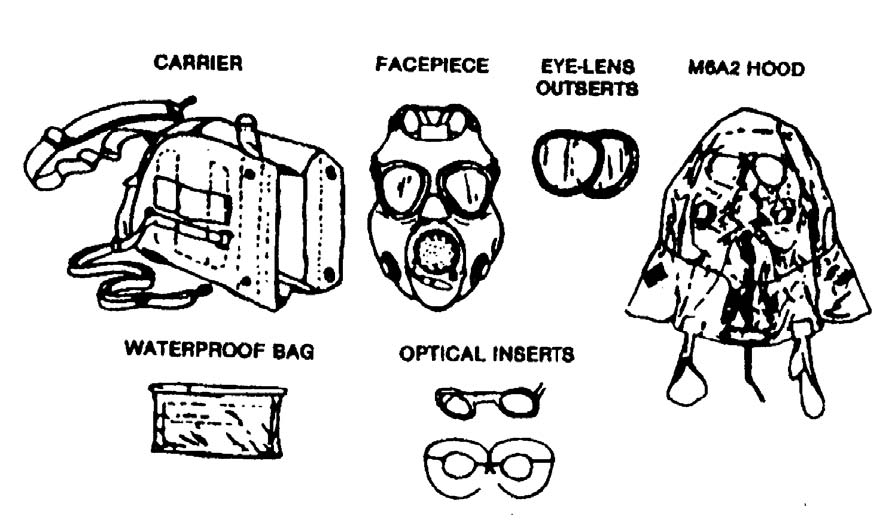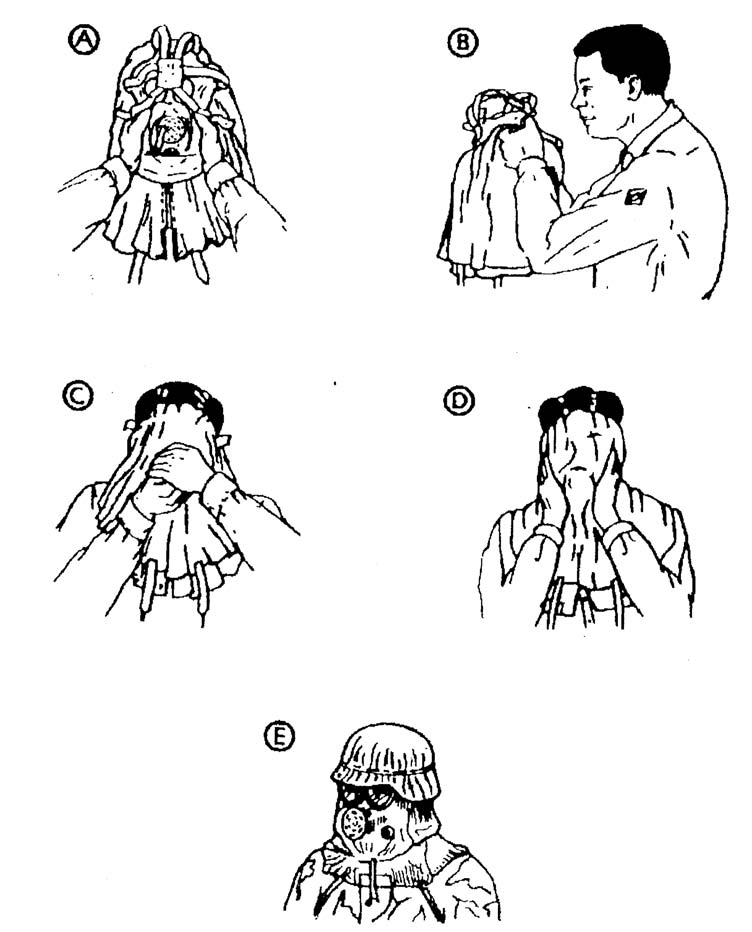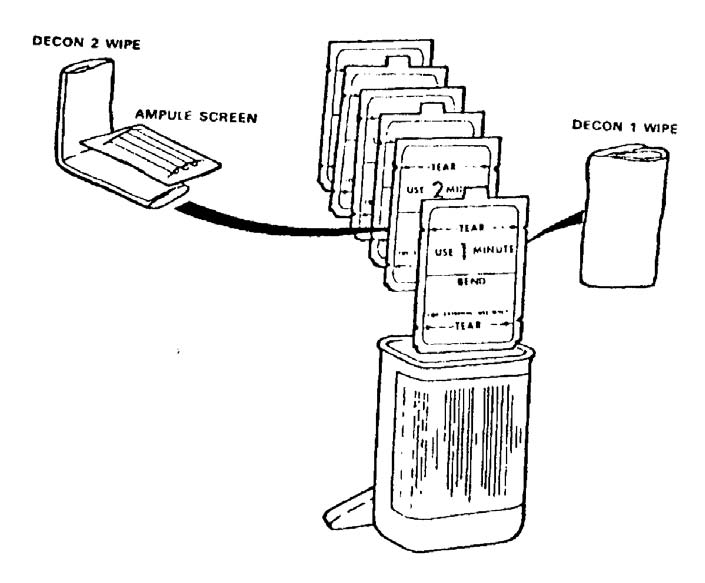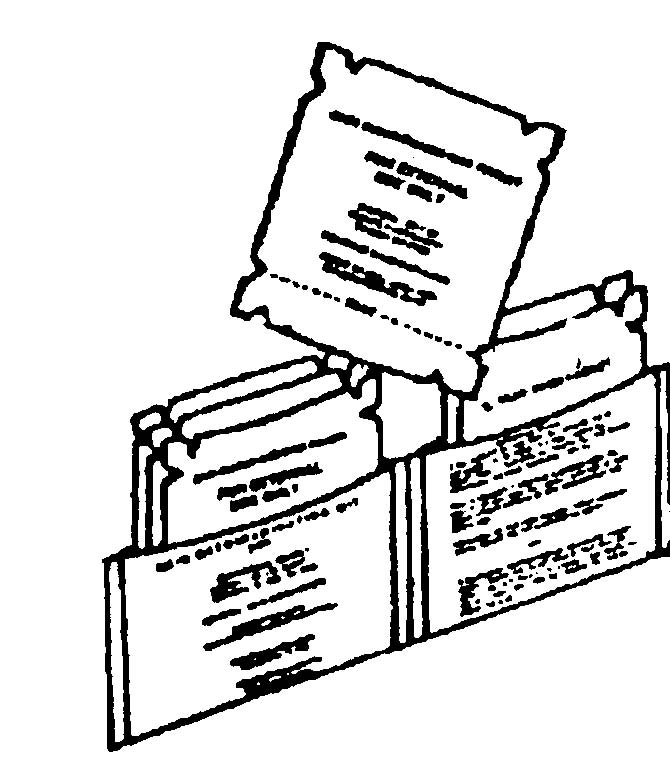Treating Chemical and Biological Agent Casualties
Lesson 1: Chemical Agents and Protection From Chemical Agents
1-12
1-12. PROTECTIVE MASK AND HOOD
Your field chemical-biological mask, when properly fitted and worn with the hood, protects against field concentrations of all known chemical and biological agents in vapor or aerosol form. It also provides protection against inhaling radioactive particles (fallout). The filter elements in the cheeks of the facepiece removes chemical and biological agents and most other contaminants from the available air, but it does not filter out carbon monoxide or ammonia vapors. The mask cannot increase the oxygen content of air and is not used when the problem is a low concentration of oxygen, such as rescue efforts in a cave where a fire has used up much of the available oxygen. Figure 1-2 shows the M17A2 mask, hood, and additional authorized items issued to every soldier. The protective masks used by tank and aircraft personnel allow for greater vision and attach to a filter system that filters the air and also controls the temperature of the air.
Figure 1-2. M17A2 mask and hood.
a. M17A2 Mask and Additional Items. The following information refers to the M17A2 mask and accessories.
(1) Facepiece. The facepiece covers the wearer's face. The filter elements protect against chemical and biological agents being inhaled or coming into contact with the eyes. The facepiece also contains a voicemitter to facilitate communication and a tube used in drinking water from a canteen while masked. Two outserts protect the eye lenses and prevents fogging in low temperatures.
(2) Hood. The ABC-M6A2 hood attaches to the mask and covers the casualty's head, neck, and shoulders from chemical agent vapor and droplets, biting insects (biological agents), and radioactive dust particles.
(3) Inserts. Optical inserts are used by soldiers who require vision correction (eyeglasses).
(4) Bag. The M1A1 waterproof bag is used to protect the mask, especially the filter elements, from damage by water.
(5) Winterizing kit. The M4 mask winterization kit is used when the temperature is below -20oF (-29oC). The kit prevents frost accumulation on the inlet valve caps. Using the kit makes breathing more difficult (increases breathing resistance).
(6) Carrier. The carrier is used to store the mask, accessories, and other items such as M8 detection paper and MARK I auto injectors.
b. Putting on the M17A2 Mask. You should be able to put on, clear, and check your M17-series mask (first 12 steps) within 9 seconds. You should be able to put on your hood (steps 13 and 14) within an additional 6 seconds. The following are procedures for donning your mask and hood (see figure 1-3).
(1) Stop breathing. Do not inhale prior to masking.
(2) Remove your helmet. Place it in a convenient location that is not contaminated, if possible.
(3) Take off your eyeglasses, if worn, and store them in a safe location such as a pocket of your overgarment.
(4) Open your mask carrier with one hand and grasp your mask just below the eyepiece with your other hand.
(5) Pull the mask out of the carrier, letting the hood hang inside out in front of the facepiece (figure 1-3A).
(6) Grasp the facepiece with both hands, slide your thumbs up and inside the mask, and open the head harness and faceplate as wide as you can.
(7) Put your chin in the chin pocket (figure 1-3B).
(8) Pull the head harness up over your head, making sure the head pad is centered at the top back of your head and the mask is smooth against your face and forehead. Do not put the head harness over the head first, and then pull the mask down over your face.
Figure 1-3. Putting on the mask.
(9) Grasp the cheek straps with both hands and adjust them with moderate jerks.
(10) Clear your mask.
(a) Cover the outlet valve with the heel of one hand and cover the voicemitter with the other hand. You can do this with your hands over the hood (hood between the hands and mask as shown in figure 1-3C) or under the hood.
(b) Apply pressure with both hands to seal the outlet valve and voicemitter.
(c) Blow hard to force air out around the edges of the mask. You should feel the air escaping around the edges of the mask.
(11) Check your mask for leaks.
(a) Place the palms of your hands over both inlet valve caps. You can do this with your hands over the hood (figure 1-3D) or under the hood.
(b) Apply pressure with both hands to seal the inlet valves.
(c) Inhale forcibly and hold your breath. If there are no leaks, your mask will collapse against your face and stay that way until you exhale.
(d) If your mask does not collapse, stop breathing and check to see if anything (hair, clothing, and so forth) is between your face and the mask. Also check the head straps and head pad to see if they are twisted. Remove anything between your mask and face and untwist any twisted straps. Tighten the head straps if needed. Then clear and check your mask again.
(12) Resume normal breathing.
(13) Pull the hood up and over your head and down onto your shoulders. If you have not yet put on your protective overgarment, delay step 14 until you have donned the overgarment.
(14) Zip the front of the hood. Make sure it is closed all the way. Make sure the edge of the hood does not get caught in the collar of the overgarment.
(15) Pull the draw cord slider snug.
(16) Fasten and adjust the underarm straps. Have another soldier assist you if possible (buddy-aid).
(17) Replace your headgear (apply helmet cover (figure 1-3E).
c. M40 Field Protective Mask. The M40-series chemical-biological mask (figure 1-4) is currently being issued to units and will replace the M17-series protective mask as it becomes available. It will become the standard Army field mask. The M40 mask consists of a silicone rubber face piece with in-turned periphery, binocular eye lens system, and elastic head harness. Other features include front and side voicemitters, allowing better communication, drink tube, clear and tinted inserts, and a filter canister with NATO standard threads. The M40 mask provides respiratory, eye, and face protection against CB agents, toxins, radioactive fallout particles, and battlefield contaminants. The canister filter cannot be changed in a contaminated environment. Instructions for care and maintenance of the M40 mask are found in TMs 3-4240-280-10-1 and 3-4240-300-20&P.
Figure 1-4. M40 mask and additional authorized items.
d. Decontamination Kits. If your skin or the interior of the mask is contaminated with nerve agent, decontaminate using a M258A1 (figure 1-5) or M291 (figure 1-6) decontamination kit.
Figure 1-5. M258A1 skin decontamination kit.
Figure 1-6. M291 skin/equipment decontamination kit.






